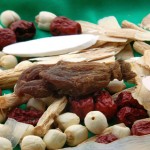I recently had an interesting herbal encounter with a patient. She was telling me that she’s taking a Chinese herbal formula from her physician that was full of Chinese herbs that are “adaptogens”. I was absolutely intrigued. When I asked her exactly what was in it, she couldn’t remember any specific herbs but was sure that it contained a long list of Chinese herbs. My understanding of Chinese herbal adaptogens is new and still in progress. This understanding of herbs is a modern approach to Chinese herbalism and I often struggle to find a balance between classical and modern Chinese herbalism.
Classically, Chinese herbs are arranged into categories that describe the general function of herbs. For example, herbs that tonify qi, drain dampness, clear heat, etc. Within each category, each individual herb has its own taste, temperature and specific function. The properties of each herb are important in herbal formulas and modifications. Herbs are always prescribed as formulas, or combinations of herb that achieve a specific treatment principal. (In fact, the text book for formulas is called “Formulas and Strategies” because a formula is indeed a strategy for treatment.) The effectiveness of a formula comes from the synergistic qualities of all the herbs. This is important to keep in mind when new research comes out regarding specific pharmaceutical properties of individual herbs. Sometimes people hear in the news about a Chinese herb that has “estrogenic effects” or have questionable side effects. This sort of information completely discounts the nature of classic herbal formulations. Sure, one herb contains a variety of actions but when it is used in a formula with several other herbs, specific effects of single herbs become moderated. That’s the beauty of Chinese herbalism! Formulas were designed to offset any “negative side effects” and to balance the herbs to yield the best effect for the patient (and, ideally, with NO side effects).
Now back to adaptogens. Needless to say, the classic material medica (Chinese herbal compilation) did not identify those herbs that can be classified as adaptogens. It is very exciting to practice Chinese herablism in an age where scientific research is able to determine these more fine-tuned properties of herbs. However, it can become overwhelming when writing formulas for my patients. I welcome these discoveries and always include the modern strategies in my formulas. However, I stay focused on the classic Chinese medical approach in choosing the basis of formulas and incorporate the modern approach in making modifications. I hope that by balancing old and new strategies, my patients will find relief in their symptoms and make better progress towards healing!


Leave a Reply